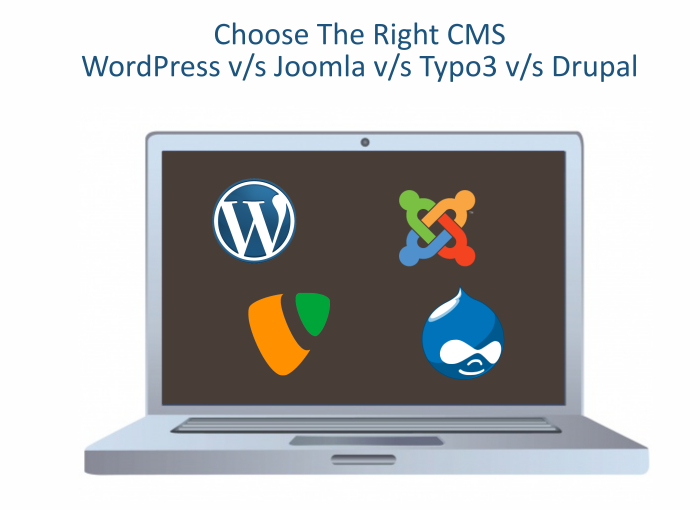Choose The Right CMS – WordPress V/S Joomla V/S Typo3 V/S Drupal


Content Management Systems have succeeded in becoming one of the most powerful web developers tools since PHP. Today, more and more web developers will be found trending towards open source CMS platforms to get their job done. Unfortunately, there are thousands of CMS’s floating around the web and finding the right one seems to be incredibly tricky. The following post explores a comparative study on the four major CMS platforms:
| Features | Typo3 | Drupal | Joomla | WordPress |
| Website | typo3.com | drupal.org | joomla.com | wordpress.org |
| Available since | 2000 | 2001 | 2005 | 2003 |
| Open Source license | GNU General Public License | |||
| Programming language | PHP | |||
| Available In Number of languages | 50 | 181 | > 60 | 50 |
| Used for | Medium-sized & large companies, esp. international organizations | Medium-sized & large companies | Small companies | Small companies and blogs |
| Strengths | Stability, localization, feature-rich, investment security | Barrier-free for editors | Interfaces, single-site installation | Blog functionality, configurable for editors |
| Plugins/Market Place | Yes | |||
| Weakness | Steep learning curve for developers | Steep learning curve for developers | Poor feature set for international websites | Vulnerable for security issues |
 WordPress :
WordPress :WordPress was introduced as a pure weblog system which can be easily converted to a Web Content Management System, of course with considerable effort.
Highlights/ Advantages/ Disadvantages

Another important web content management system worth considering is Joomla. With its origins in the open source project Mambo, Joomla turns out to be entirely object-oriented and components adhere to the Model View Controller (MVC) design principles. By using Joomla as a framework and its corresponding API, one can easily end up creating extensions and web applications using the framework. The new Joomla User Interface (JUI) library allows a user to individually customize extensions. Thus, it is used to subsequently implement additional enterprise features such as SAP connectors or similar features.
Highlights/ Advantages/ Disadvantages
 Typo3
Typo3Unlike other open sources available in the market, most of the web development companies believe Typo3 as one of the mature, feature-complete enterprise web content management system. In fact, the platform offers connections to numerous third-party systems that are already present in the existing software architecture.
Highlights/ Advantages/ Disadvantages
Fortunately, Typo3 fulfills almost all the requirements that companies place on a license-free content management system. Starting from supporting global websites through Multilanguage- and localization features to connect to nay software system, comprehensive system for user authorization and access, the platform offers an endless number of possibilities such as:
Unlike Joomla or Typo3 which are pure-play web content management systems or WordPress which are often used as a blog software, Drupal follows the approach of combining simple web content management with social community software. In addition to this, Drupal strongly focuses on providing an extensive set of social community tools.
Highlights/ Advantages/ Disadvantages
